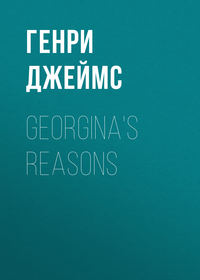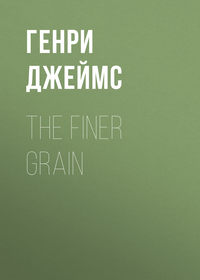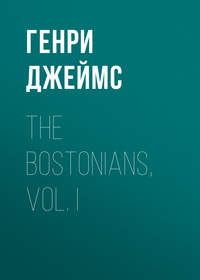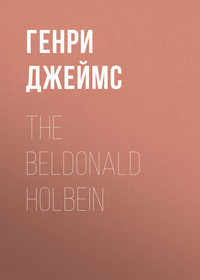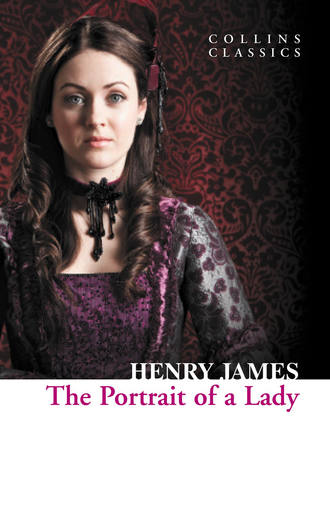
Полная версия
The Portrait of a Lady

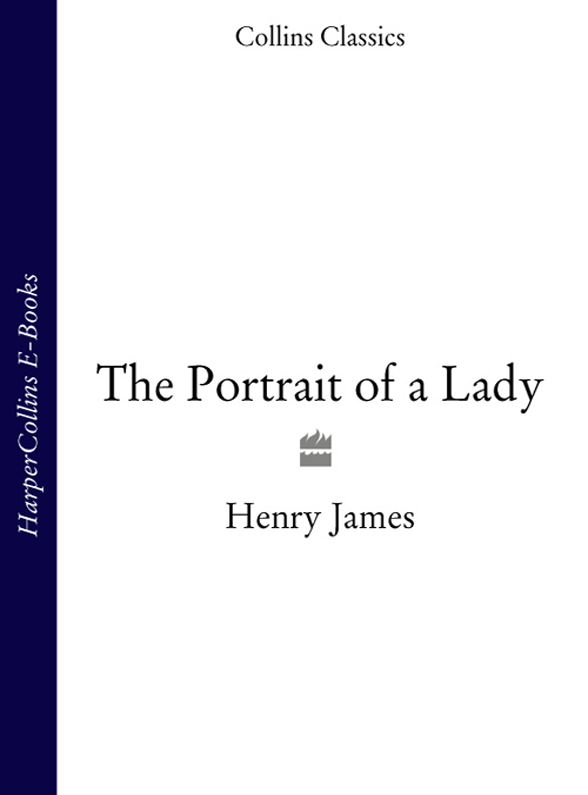
THE PORTRAIT OF A LADY
Henry James

CONTENTS
Cover
Title Page
Volume I (of II)
Preface
Chapter 1
Chapter 2
Chapter 3
Chapter 4
Chapter 5
Chapter 6
Chapter 7
Chapter 8
Chapter 9
Chapter 10
Chapter 11
Chapter 12
Chapter 13
Chapter 14
Chapter 15
Chapter 16
Chapter 17
Chapter 18
Chapter 19
Chapter 20
Chapter 21
Chapter 22
Chapter 23
Chapter 24
Chapter 25
Chapter 26
Chapter 27
Volume II (of II)
Chapter 28
Chapter 29
Chapter 30
Chapter 31
Chapter 32
Chapter 33
Chapter 34
Chapter 35
Chapter 36
Chapter 37
Chapter 38
Chapter 39
Chapter 40
Chapter 41
Chapter 42
Chapter 43
Chapter 44
Chapter 45
Chapter 46
Chapter 47
Chapter 48
Chapter 49
Chapter 50
Chapter 51
Chapter 52
Chapter 53
Chapter 54
Chapter 55
Classic Literature: Words and Phrases Adapted from the Collins English Dictionary
About the Author
History of Collins
Copyright
About the Publisher
PREFACE
“The Portrait of a Lady” was, like “Roderick Hudson”, begun in Florence, during three months spent there in the spring of 1879. Like “Roderick” and like “The American”, it had been designed for publication in “The Atlantic Monthly”, where it began to appear in 1880. It differed from its two predecessors, however, in finding a course also open to it, from month to month, in “Macmillan’s Magazine”; which was to be for me one of the last occasions of simultaneous “serialisation” in the two countries that the changing conditions of literary intercourse between England and the United States had up to then left unaltered. It is a long novel, and I was long in writing it; I remember being again much occupied with it, the following year, during a stay of several weeks made in Venice. I had rooms on Riva Schiavoni, at the top of a house near the passage leading off to San Zaccaria; the waterside life, the wondrous lagoon spread before me, and the ceaseless human chatter of Venice came in at my windows, to which I seem to myself to have been constantly driven, in the fruitless fidget of composition, as if to see whether, out in the blue channel, the ship of some right suggestion, of some better phrase, of the next happy twist of my subject, the next true touch for my canvas, mightn’t come into sight. But I recall vividly enough that the response most elicited, in general, to these restless appeals was the rather grim admonition that romantic and historic sites, such as the land of Italy abounds in, offer the artist a questionable aid to concentration when they themselves are not to be the subject of it. They are too rich in their own life and too charged with their own meanings merely to help him out with a lame phrase; they draw him away from his small question to their own greater ones; so that, after a little, he feels, while thus yearning toward them in his difficulty, as if he were asking an army of glorious veterans to help him to arrest a peddler who has given him the wrong change.
There are pages of the book which, in the reading over, have seemed to make me see again the bristling curve of the wide Riva, the large colour-spots of the balconied houses and the repeated undulation of the little hunchbacked bridges, marked by the rise and drop again, with the wave, of foreshortened clicking pedestrians. The Venetian footfall and the Venetian cry—all talk there, wherever uttered, having the pitch of a call across the water—come in once more at the window, renewing one’s old impression of the delighted senses and the divided, frustrated mind. How can places that speak IN GENERAL so to the imagination not give it, at the moment, the particular thing it wants? I recollect again and again, in beautiful places, dropping into that wonderment. The real truth is, I think, that they express, under this appeal, only too much—more than, in the given case, one has use for; so that one finds one’s self working less congruously, after all, so far as the surrounding picture is concerned, than in presence of the moderate and the neutral, to which we may lend something of the light of our vision. Such a place as Venice is too proud for such charities; Venice doesn’t borrow, she but all magnificently gives. We profit by that enormously, but to do so we must either be quite off duty or be on it in her service alone. Such, and so rueful, are these reminiscences; though on the whole, no doubt, one’s book, and one’s “literary effort” at large, were to be the better for them. Strangely fertilising, in the long run, does a wasted effort of attention often prove. It all depends on HOW the attention has been cheated, has been squandered. There are high-handed insolent frauds, and there are insidious sneaking ones. And there is, I fear, even on the most designing artist’s part, always witless enough good faith, always anxious enough desire, to fail to guard him against their deceits.
Trying to recover here, for recognition, the germ of my idea, I see that it must have consisted not at all in any conceit of a “plot”, nefarious name, in any flash, upon the fancy, of a set of relations, or in any one of those situations that, by a logic of their own, immediately fall, for the fabulist, into movement, into a march or a rush, a patter of quick steps; but altogether in the sense of a single character, the character and aspect of a particular engaging young woman, to which all the usual elements of a “subject”, certainly of a setting, were to need to be super added. Quite as interesting as the young woman herself at her best, do I find, I must again repeat, this projection of memory upon the whole matter of the growth, in one’s imagination, of some such apology for a motive. These are the fascinations of the fabulist’s art, these lurking forces of expansion, these necessities of upspringing in the seed, these beautiful determinations, on the part of the idea entertained, to grow as tall as possible, to push into the light and the air and thickly flower there; and, quite as much, these fine possibilities of recovering, from some good standpoint on the ground gained, the intimate history of the business—of retracing and reconstructing its steps and stages. I have always fondly remembered a remark that I heard fall years ago from the lips of Ivan Turgenieff in regard to his own experience of the usual origin of the fictive picture. It began for him almost always with the vision of some person or persons, who hovered before him, soliciting him, as the active or passive figure, interesting him and appealing to him just as they were and by what they were. He saw them, in that fashion, as disponibles, saw them subject to the chances, the complications of existence, and saw them vividly, but then had to find for them the right relations, those that would most bring them out; to imagine, to invent and select and piece together the situations most useful and favourable to the sense of the creatures themselves, the complications they would be most likely to produce and to feel.
“To arrive at these things is to arrive at my story,” he said, “and that’s the way I look for it. The result is that I’m often accused of not having ‘story’ enough. I seem to myself to have as much as I need—to show my people, to exhibit their relations with each other; for that is all my measure. If I watch them long enough I see them come together, I see them PLACED, I see them engaged in this or that act and in this or that difficulty. How they look and move and speak and behave, always in the setting I have found for them, is my account of them—of which I dare say, alas, que cela manque souvent d’architecture. But I would rather, I think, have too little architecture than too much—when there’s danger of its interfering with my measure of the truth. The French of course like more of it than I give—having by their own genius such a hand for it; and indeed one must give all one can. As for the origin of one’s wind-blown germs themselves, who shall say, as you ask, where THEY come from? We have to go too far back, too far behind, to say. Isn’t it all we can say that they come from every quarter of heaven, that they are THERE at almost any turn of the road? They accumulate, and we are always picking them over, selecting among them. They are the breath of life—by which I mean that life, in its own way, breathes them upon us. They are so, in a manner prescribed and imposed—floated into our minds by the current of life. That reduces to imbecility the vain critic’s quarrel, so often, with one’s subject, when he hasn’t the wit to accept it. Will he point out then which other it should properly have been?—his office being, essentially to point out. Il en serait bien embarrasse. Ah, when he points out what I’ve done or failed to do with it, that’s another matter: there he’s on his ground. I give him up my ‘sarchitecture,’” my distinguished friend concluded, “as much as he will.”
So this beautiful genius, and I recall with comfort the gratitude I drew from his reference to the intensity of suggestion that may reside in the stray figure, the unattached character, the image en disponibilite. It gave me higher warrant than I seemed then to have met for just that blest habit of one’s own imagination, the trick of investing some conceived or encountered individual, some brace or group of individuals, with the germinal property and authority. I was myself so much more antecedently conscious of my figures than of their setting—a too preliminary, a preferential interest in which struck me as in general such a putting of the cart before the horse. I might envy, though I couldn’t emulate, the imaginative writer so constituted as to see his fable first and to make out its agents afterwards. I could think so little of any fable that didn’t need its agents positively to launch it; I could think so little of any situation that didn’t depend for its interest on the nature of the persons situated, and thereby on their way of taking it. There are methods of so-called presentation, I believe among novelists who have appeared to flourish—that offer the situation as indifferent to that support; but I have not lost the sense of the value for me, at the time, of the admirable Russian’s testimony to my not needing, all superstitiously, to try and perform any such gymnastic. Other echoes from the same source linger with me, I confess, as unfadingly—if it be not all indeed one much-embracing echo. It was impossible after that not to read, for one’s uses, high lucidity into the tormented and disfigured and bemuddled question of the objective value, and even quite into that of the critical appreciation, of “subject” in the novel.
One had had from an early time, for that matter, the instinct of the right estimate of such values and of its reducing to the inane the dull dispute over the “immoral” subject and the moral. Recognising so promptly the one measure of the worth of a given subject, the question about it that, rightly answered, disposes of all others—is it valid, in a word, is it genuine, is it sincere, the result of some direct impression or perception of life?—I had found small edification, mostly, in a critical pretension that had neglected from the first all delimitation of ground and all definition of terms. The air of my earlier time shows, to memory, as darkened, all round, with that vanity—unless the difference to-day be just in one’s own final impatience, the lapse of one’s attention. There is, I think, no more nutritive or suggestive truth in this connexion than that of the perfect dependence of the “moral” sense of a work of art on the amount of felt life concerned in producing it. The question comes back thus, obviously, to the kind and the degree of the artist’s prime sensibility, which is the soil out of which his subject springs. The quality and capacity of that soil, its ability to “grow” with due freshness and straightness any vision of life, represents, strongly or weakly, the projected morality. That element is but another name for the more or less close connexion of the subject with some mark made on the intelligence, with some sincere experience. By which, at the same time, of course, one is far from contending that this enveloping air of the artist’s humanity—which gives the last touch to the worth of the work—is not a widely and wondrously varying element; being on one occasion a rich and magnificent medium and on another a comparatively poor and ungenerous one. Here we get exactly the high price of the novel as a literary form—its power not only, while preserving that form with closeness, to range through all the differences of the individual relation to its general subject-matter, all the varieties of outlook on life, of disposition to reflect and project, created by conditions that are never the same from man to man (or, so far as that goes, from man to woman), but positively to appear more true to its character in proportion as it strains, or tends to burst, with a latent extravagance, its mould.
The house of fiction has in short not one window, but a million—a number of possible windows not to be reckoned, rather; every one of which has been pierced, or is still pierceable, in its vast front, by the need of the individual vision and by the pressure of the individual will. These apertures, of dissimilar shape and size, hang so, all together, over the human scene that we might have expected of them a greater sameness of report than we find. They are but windows at the best, mere holes in a dead wall, disconnected, perched aloft; they are not hinged doors opening straight upon life. But they have this mark of their own that at each of them stands a figure with a pair of eyes, or at least with a field-glass, which forms, again and again, for observation, a unique instrument, insuring to the person making use of it an impression distinct from every other. He and his neighbours are watching the same show, but one seeing more where the other sees less, one seeing black where the other sees white, one seeing big where the other sees small, one seeing coarse where the other sees fine. And so on, and so on; there is fortunately no saying on what, for the particular pair of eyes, the window may NOT open; “fortunately” by reason, precisely, of this incalculability of range. The spreading field, the human scene, is the “choice of subject”; the pierced aperture, either broad or balconied or slit-like and low-browed, is the “literary form”; but they are, singly or together, as nothing without the posted presence of the watcher—without, in other words, the consciousness of the artist. Tell me what the artist is, and I will tell you of what he has BEEN conscious. Thereby I shall express to you at once his boundless freedom and his “moral” reference.
All this is a long way round, however, for my word about my dim first move toward “The Portrait,” which was exactly my grasp of a single character—an acquisition I had made, moreover, after a fashion not here to be retraced. Enough that I was, as seemed to me, in complete possession of it, that I had been so for a long time, that this had made it familiar and yet had not blurred its charm, and that, all urgently, all tormentingly, I saw it in motion and, so to speak, in transit. This amounts to saying that I saw it as bent upon its fate—some fate or other; which, among the possibilities, being precisely the question. Thus I had my vivid individual—vivid, so strangely, in spite of being still at large, not confined by the conditions, not engaged in the tangle, to which we look for much of the impress that constitutes an identity. If the apparition was still all to be placed how came it to be vivid?—since we puzzle such quantities out, mostly, just by the business of placing them. One could answer such a question beautifully, doubtless, if one could do so subtle, if not so monstrous, a thing as to write the history of the growth of one’s imagination. One would describe then what, at a given time, had extraordinarily happened to it, and one would so, for instance, be in a position to tell, with an approach to clearness, how, under favour of occasion, it had been able to take over (take over straight from life) such and such a constituted, animated figure or form. The figure has to that extent, as you see, BEEN placed—placed in the imagination that detains it, preserves, protects, enjoys it, conscious of its presence in the dusky, crowded, heterogeneous back-shop of the mind very much as a wary dealer in precious odds and ends, competent to make an “advance” on rare objects confided to him, is conscious of the rare little “piece” left in deposit by the reduced, mysterious lady of title or the speculative amateur, and which is already there to disclose its merit afresh as soon as a key shall have clicked in a cupboard-door.
That may he, I recognise, a somewhat superfine analogy for the particular “value” I here speak of, the image of the young feminine nature that I had had for so considerable a time all curiously at my disposal; but it appears to fond memory quite to fit the fact—with the recall, in addition, of my pious desire but to place my treasure right. I quite remind myself thus of the dealer resigned not to “realise”, resigned to keeping the precious object locked up indefinitely rather than commit it, at no matter what price, to vulgar hands. For there ARE dealers in these forms and figures and treasures capable of that refinement. The point is, however, that this single small corner-stone, the conception of a certain young woman affronting her destiny, had begun with being all my outfit for the large building of “The Portrait of a Lady”. It came to be a square and spacious house—or has at least seemed so to me in this going over it again; but, such as it is, it had to be put up round my young woman while she stood there in perfect isolation. That is to me, artistically speaking, the circumstance of interest; for I have lost myself once more, I confess, in the curiosity of analysing the structure. By what process of logical accretion was this slight “personality”, the mere slim shade of an intelligent but presumptuous girl, to find itself endowed with the high attributes of a Subject?—and indeed by what thinness, at the best, would such a subject not be vitiated? Millions of presumptuous girls, intelligent or not intelligent, daily affront their destiny, and what is it open to their destiny to be, at the most, that we should make an ado about it? The novel is of its very nature an “ado”, an ado about something, and the larger the form it takes the greater of course the ado. Therefore, consciously, that was what one was in for—for positively organising an ado about Isabel Archer.
One looked it well in the face, I seem to remember, this extravagance; and with the effect precisely of recognising the charm of the problem. Challenge any such problem with any intelligence, and you immediately see how full it is of substance; the wonder being, all the while, as we look at the world, how absolutely, how inordinately, the Isabel Archers, and even much smaller female fry, insist on mattering. George Eliot has admirably noted it—“In these frail vessels is borne onward through the ages the treasure of human affection.” In “Romeo and Juliet” Juliet has to be important, just as, in “Adam Bede” and “The Mill on the Floss” and “Middlemarch” and “Daniel Deronda”, Hetty Sorrel and Maggie Tulliver and Rosamond Vincy and Gwendolen Harleth have to be; with that much of firm ground, that much of bracing air, at the disposal all the while of their feet and their lungs. They are typical, none the less, of a class difficult, in the individual case, to make a centre of interest; so difficult in fact that many an expert painter, as for instance Dickens and Walter Scott, as for instance even, in the main, so subtle a hand as that of R. L. Stevenson, has preferred to leave the task unattempted. There are in fact writers as to whom we make out that their refuge from this is to assume it to be not worth their attempting; by which pusillanimity in truth their honour is scantly saved. It is never an attestation of a value, or even of our imperfect sense of one, it is never a tribute to any truth at all, that we shall represent that value badly. It never makes up, artistically, for an artist’s dim feeling about a thing that he shall “do” the thing as ill as possible. There are better ways than that, the best of all of which is to begin with less stupidity.
It may be answered meanwhile, in regard to Shakespeare’s and to George Eliot’s testimony, that their concession to the “importance” of their Juliets and Cleopatras and Portias (even with Portia as the very type and model of the young person intelligent and presumptuous) and to that of their Hettys and Maggies and Rosamonds and Gwendolens, suffers the abatement that these slimnesses are, when figuring as the main props of the theme, never suffered to be sole ministers of its appeal, but have their inadequacy eked out with comic relief and underplots, as the playwrights say, when not with murders and battles and the great mutations of the world. If they are shown as “mattering” as much as they could possibly pretend to, the proof of it is in a hundred other persons, made of much stouter stuff; and each involved moreover in a hundred relations which matter to THEM concomitantly with that one. Cleopatra matters, beyond bounds, to Antony, but his colleagues, his antagonists, the state of Rome and the impending battle also prodigiously matter; Portia matters to Antonio, and to Shylock, and to the Prince of Morocco, to the fifty aspiring princes, but for these gentry there are other lively concerns; for Antonio, notably, there are Shylock and Bassanio and his lost ventures and the extremity of his predicament. This extremity indeed, by the same token, matters to Portia—though its doing so becomes of interest all by the fact that Portia matters to US. That she does so, at any rate, and that almost everything comes round to it again, supports my contention as to this fine example of the value recognised in the mere young thing. (I say “mere” young thing because I guess that even Shakespeare, preoccupied mainly though he may have been with the passions of princes, would scarce have pretended to found the best of his appeal for her on her high social position.) It is an example exactly of the deep difficulty braved—the difficulty of making George Eliot’s “frail vessel,” if not the all-in-all for our attention, at least the clearest of the call.
Now to see deep difficulty braved is at any time, for the really addicted artist, to feel almost even as a pang the beautiful incentive, and to feel it verily in such sort as to wish the danger intensified. The difficulty most worth tackling can only be for him, in these conditions, the greatest the case permits of. So I remember feeling here (in presence, always, that is, of the particular uncertainty of my ground), that there would be one way better than another—oh, ever so much better than any other!—of making it fight out its battle. The frail vessel, that charged with George Eliot’s “treasure”, and thereby of such importance to those who curiously approach it, has likewise possibilities of importance to itself, possibilities which permit of treatment and in fact peculiarly require it from the moment they are considered at all. There is always the escape from any close account of the weak agent of such spells by using as a bridge for evasion, for retreat and flight, the view of her relation to those surrounding her. Make it predominantly a view of THEIR relation and the trick is played: you give the general sense of her effect, and you give it, so far as the raising on it of a superstructure goes, with the maximum of ease. Well, I recall perfectly how little, in my now quite established connexion, the maximum of ease appealed to me, and how I seemed to get rid of it by an honest transposition of the weights in the two scales. “Place the centre of the subject in the young woman’s own consciousness,” I said to myself, “and you get as interesting and as beautiful a difficulty as you could wish. Stick to THAT—for the centre; put the heaviest weight into THAT scale, which will be so largely the scale of her relation to herself. Make her only interested enough, at the same time, in the things that are not herself, and this relation needn’t fear to be too limited. Place meanwhile in the other scale the lighter weight (which is usually the one that tips the balance of interest): press least hard, in short, on the consciousness of your heroine’s satellites, especially the male; make it an interest contributive only to the greater one. See, at all events, what can be done in this way. What better field could there be for a due ingenuity? The girl hovers, inextinguishable, as a charming creature, and the job will be to translate her into the highest terms of that formula, and as nearly as possible moreover into ALL of them. To depend upon her and her little concerns wholly to see you through will necessitate, remember, your really ‘doing’ her.”




